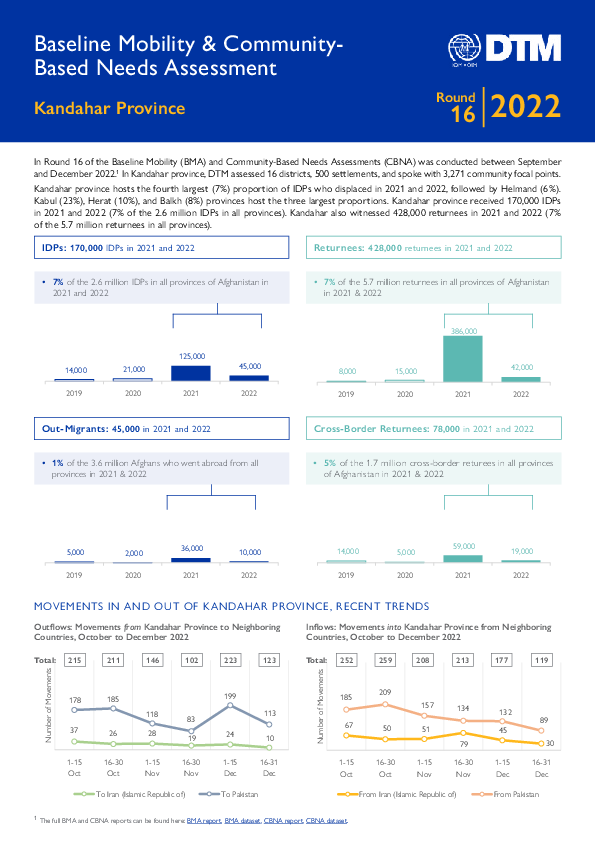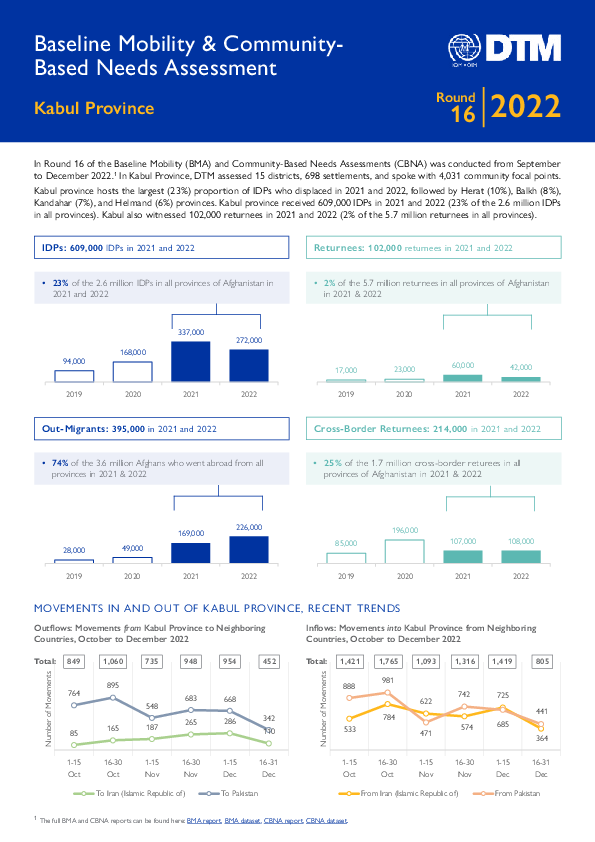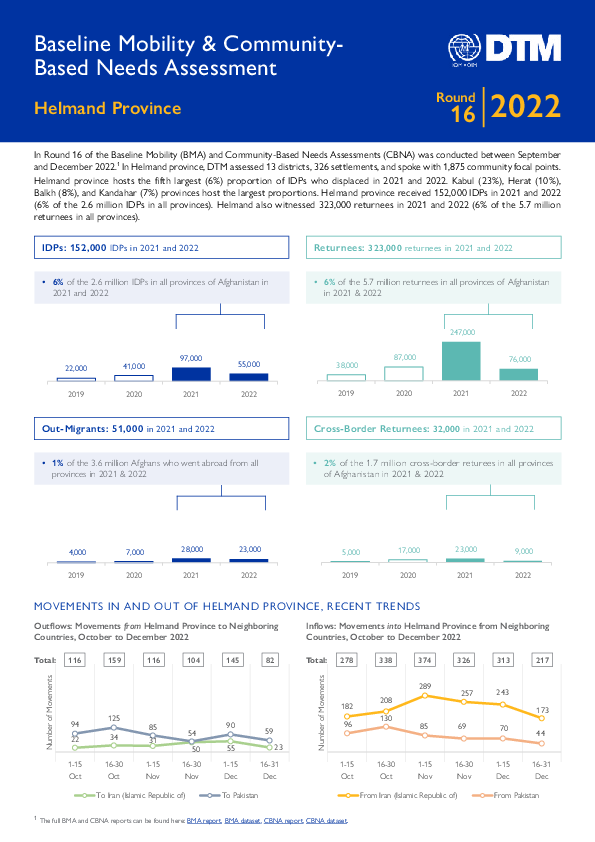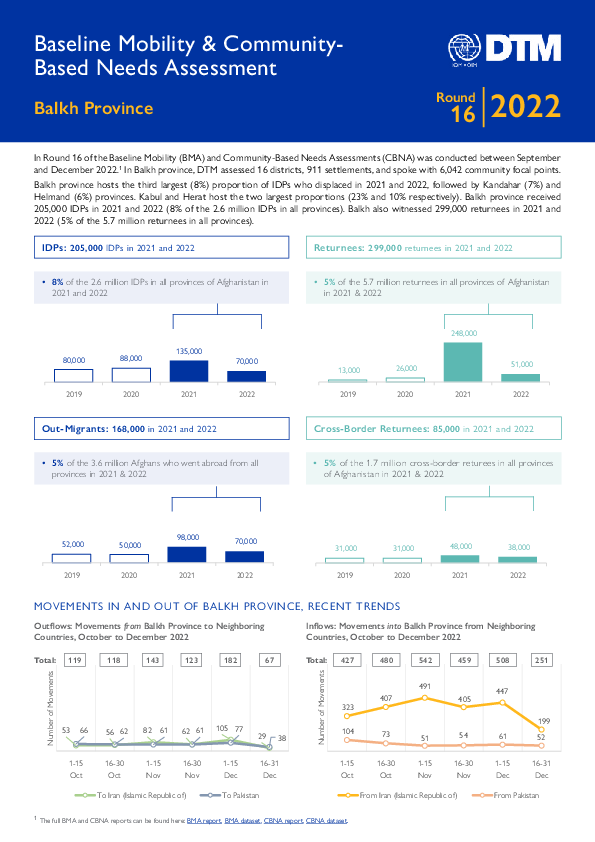-
Countries
-
Data and Analysis
-
Special Focus
-
Crisis Responses
Site Assessment

Contact
dtmhaiti@iom.int
Language
French
Location
Haiti
Period Covered
Jun 12 2023
Jul 03 2023
Activity
- Mobility Tracking
- Site Assessment
- Baseline Assessment
- Village Assessment
Au cours des dernières années, l’insécurité généralisée en Haïti a poussé des milliers de personnes à fuir leurs zones de résidence. Bien que les violences surviennent le plus souvent dans la Zone Métropolitaine de Port-au-Prince (ZMPP) située dans le département de l’Ouest, d’autres départements sont aussi affectés. Ceci est notamment le cas de départements du Centre et de l'Artibonite.
Afin d’informer régulièrement les autorités ainsi que d’autres partenaires sur la situation de déplacement dans les départements de l'Ouest, du Centre et de l'Artibonite, la Direction Générale de la Protection Civile (DGPC) et la matrice de suivi des déplacements (DTM) de l’OIM ont mené en juin 2023 des activités d’évaluations dans les sections communales, quartiers et sites accueillant les populations déplacées dans ces départements.
Ce tableau de bord présente la synthèse de résultats issus de ces collectes de données
Contact
DTM Nigeria, AllUsersInDTMNigeria@iom.int
Location
Nigeria
Activity
- Mobility Tracking
- Site Assessment
Period Covered
Dec 03 2022 -Dec 31 2022
A site assessment is a sub-component of mobility tracking. It aims to collect data on population presence, living conditions and needs in a particular displacement site or community.
Round 11 of DTM data collection in Nigeria’s north-west and north-central geopolitical zones was conducted between 03
and 30 December 2022. During the assessments, DTM deployed teams of enumerators to conduct assessments in 881
wards (up from the 856 wards assessed in Round 10 of DTM assessments), located in 180 LGAs (up from 174 LGAs in
Round 10). Eight states were covered, including Benue, Nasarawa and Plateau (north-central) and Kaduna, Kano, Sokoto,
Katsina and Zamfara (north-west).
DTM enumerators conducted assessments in 1,758 locations (an increase of 68 locations compared to Round 10), including
1,652 (94%) locations where IDPs were residing among host communities and 106 (6%) locations categorized as camps/
camp-like settings. During these assessments, data was collected on numbers, living conditions and multisectoral needs of
displaced populations.
Population Groups
Survey Methodology
Unit of Analysis Or Observation
Type of Survey or Assessment
Keywords
Geographical Scope
Administrative boundaries with available data
The current dataset covers the following administrative boundaries
Contact
DTM Nigeria, AllUsersInDTMNigeria@iom.int
Location
Nigeria
Activity
- Mobility Tracking
- Site Assessment
Period Covered
Aug 09 2022 -Oct 31 2022
A site assessment is a sub-component of mobility tracking. It aims to collect data on population presence, living conditions and needs in a particular displacement site or community.
As of October 2022, the DTM identified a total of 1,087,875 IDPs in 180,307 households in Nigeria’s north-central and north-west zones. This signifies an IDP increase of 12.2 per cent or 118,118 IDPs compared to December 2021. The IDP population included IDPs in camps and camp-like settings (217,205 individuals or 20%) and IDPs residing in host communities (870,670 individuals or 80%).
Data collection for IDPs took place between August and September 2022 in 1,690 localities in the eight states of north-central and north-west Nigeria (Benue, Kaduna, Kano, Katsina, Nasarawa, Plateau, Sokoto and Zamfara).
Population Groups
Survey Methodology
Unit of Analysis Or Observation
Type of Survey or Assessment
Keywords
Geographical Scope
Administrative boundaries with available data
The current dataset covers the following administrative boundaries

Contact
DTM CAR, DTMRCA@iom.int
Language
English
Location
Central African Republic
Period Covered
May 01 2023
Jun 08 2023
Activity
- Mobility Tracking
- Site Assessment
- Event Tracking
Ce rapport fournit un aperçu des déplacements et des besoins humanitaires multisectoriels dans les localités d’accueil des personnes déplacées internes (PDI) et / ou retournées. Les résultats ont été obtenus après la conduite du dix-huitième cycle de suivi des déplacements (round 18) réalisé entre le 01er mai et le 08 juin 2023 par l’Organisation Internationale pour les Migrations (OIM) grâce au soutien du Bureau pour l’Assistance Humanitaire (en anglais, Bureau for Humanitarian Assistance, BHA), la Direction Générale de la Protection Civile et des Opérations d’Aide Humanitaire Européennes (DG ECHO) et le Fonds Humanitaire (FH). L’évaluation a couvert 4 2001 localités d’accueil des PDI et / ou retournés et 78 sites de déplacement identifiés préalablement avec les autorités locales et avec le suivi du Ministère de l’Action Humanitaire et de la Réconcilation Nationale.

Contact
DTMAfghanistan@iom.int
Language
English
Location
Afghanistan
Period Covered
Sep 01 2022
Dec 31 2022
Activity
- Mobility Tracking
- Site Assessment
- Baseline Assessment
DTM has been conducting the Baseline Mobility Assessment (BMA) in Afghanistan since 2016 to track mobility, provide information on population estimates, locations and geographic distribution of displaced and returnee populations, reasons for displacement, places of origin and periods of displacement. The Community-Based Needs Assessment (CBNA) provides a comprehensive overview of the evolving vulnerabilities and multisectoral needs in communities hosting internally displaced persons (IDPs) and returnees from abroad.
Data is collected at the settlement level through focus group discussions with community focal points and direct observation. The figures presented in the report are estimates provided by community focal points.
This factsheet delves into the key findings in Kandahar province using the latest results from Round 16 (Sep to Dec 2022) of the BMA and CBNA, focusing on the 2021-to-2022 period.
The full report can be found here: Baseline Mobility Assessment and Community-Based Needs Assessment.

Contact
DTMAfghanistan@iom.int
Language
English
Location
Afghanistan
Period Covered
Sep 01 2022
Dec 31 2022
Activity
- Mobility Tracking
- Site Assessment
- Baseline Assessment
DTM has been conducting the Baseline Mobility Assessment (BMA) in Afghanistan since 2016 to track mobility, provide information on population estimates, locations and geographic distribution of displaced and returnee populations, reasons for displacement, places of origin and periods of displacement. The Community-Based Needs Assessment (CBNA) provides a comprehensive overview of the evolving vulnerabilities and multisectoral needs in communities hosting internally displaced persons (IDPs) and returnees from abroad.
Data is collected at the settlement level through focus group discussions with community focal points and direct observation. The figures presented in the report are estimates provided by community focal points.
This factsheet delves into the key findings in Kabul province using the latest results from Round 16 (Sep to Dec 2022) of the BMA and CBNA, focusing on the 2021-to-2022 period.
The full report can be found here: Baseline Mobility Assessment and Community-Based Needs Assessment.

Contact
DTMAfghanistan@iom.int
Language
English
Location
Afghanistan
Period Covered
Sep 01 2022
Dec 31 2022
Activity
- Mobility Tracking
- Site Assessment
- Baseline Assessment
DTM has been conducting the Baseline Mobility Assessment (BMA) in Afghanistan since 2016 to track mobility, provide information on population estimates, locations and geographic distribution of displaced and returnee populations, reasons for displacement, places of origin and periods of displacement. The Community-Based Needs Assessment (CBNA) provides a comprehensive overview of the evolving vulnerabilities and multisectoral needs in communities hosting internally displaced persons (IDPs) and returnees from abroad.
Data is collected at the settlement level through focus group discussions with community focal points and direct observation. The figures presented in the report are estimates provided by community focal points.
This factsheet delves into the key findings in Herat province using the latest results from Round 16 (Sep to Dec 2022) of the BMA and CBNA, focusing on the 2021-to-2022 period.
The full report can be found here: Baseline Mobility Assessment and Community-Based Needs Assessment.

Contact
DTMAfghanistan@iom.int
Language
English
Location
Afghanistan
Period Covered
Sep 01 2022
Dec 31 2022
Activity
- Mobility Tracking
- Site Assessment
- Baseline Assessment
DTM has been conducting the Baseline Mobility Assessment (BMA) in Afghanistan since 2016 to track mobility, provide information on population estimates, locations and geographic distribution of displaced and returnee populations, reasons for displacement, places of origin and periods of displacement. The Community-Based Needs Assessment (CBNA) provides a comprehensive overview of the evolving vulnerabilities and multisectoral needs in communities hosting internally displaced persons (IDPs) and returnees from abroad.
Data is collected at the settlement level through focus group discussions with community focal points and direct observation. The figures presented in the report are estimates provided by community focal points.
This factsheet delves into the key findings in Helmand province using the latest results from Round 16 (Sep to Dec 2022) of the BMA and CBNA, focusing on the 2021-to-2022 period.
The full report can be found here: Baseline Mobility Assessment and Community-Based Needs Assessment.

Contact
DTMAfghanistan@iom.int
Language
English
Location
Afghanistan
Period Covered
Sep 01 2022
Dec 31 2022
Activity
- Mobility Tracking
- Site Assessment
- Baseline Assessment
DTM has been conducting the Baseline Mobility Assessment (BMA) in Afghanistan since 2016 to track mobility, provide information on population estimates, locations and geographic distribution of displaced and returnee populations, reasons for displacement, places of origin and periods of displacement. The Community-Based Needs Assessment (CBNA) provides a comprehensive overview of the evolving vulnerabilities and multisectoral needs in communities hosting internally displaced persons (IDPs) and returnees from abroad.
Data is collected at the settlement level through focus group discussions with community focal points and direct observation. The figures presented in the report are estimates provided by community focal points.
This factsheet delves into the key findings in Balkh province using the latest results from Round 16 (Sep to Dec 2022) of the BMA and CBNA, focusing on the 2021-to-2022 period.
The full report can be found here: Baseline Mobility Assessment and Community-Based Needs Assessment.

Contact
DTM Ethiopia, DTMEthiopia@iom.int
Language
English
Location
Ethiopia
Period Covered
Aug 08 2022
Sep 17 2022
Activity
- Mobility Tracking
- Site Assessment
- Village Assessment
Between August and September 2022, the International Organization for Migration (IOM), through its Displacement Tracking Matrix (DTM) methodology, deployed the Site Assessment (SA) and Village Assessment Survey (VAS) tools to assess the mobility, needs and vulnerabilities of Internally Displaced Persons (IDPs) and returning IDPs across Ethiopia.
According to data collected, living conditions of IDPs in the assessed sites continue to be inadequate and unsafe. In most assessed sites, no HH was living in individual HH shelters (1,937 sites, or 88.05%). In addition, data also shows that access to emergency shelter kits is limited and that needs related to shelter are acute. In line with these findings, in 62.16% of villages, the majority of returning IDPs had not received any Non-Food Item (NFI) upon return, showing a poor situation both in the sites of displacement and villages of return.
Pagination
- Previous page
- Page 22
- Next page
